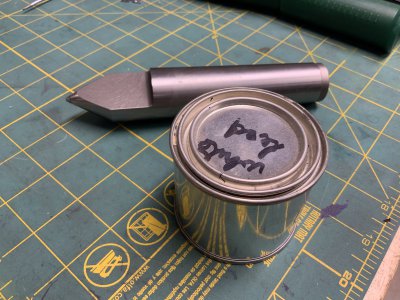- Joined
- Dec 9, 2021
- Messages
- 735
These people (A. R. Warner Co.) are not the cheapest source, but have really good stuff, and have an interest in hobby/small shop needs. The website isn't very easy to navigate, so contacting them with your needs/questions would be the best route. I couldn't find it on the website, but they used to make HHS insert bits. They may have boring bits available, too.
https://www.arwarnerco.com/category-s/142.htm
If not, you can grind the tip of a bit and cut it off by notching (all four sides) the desired length with an abrasive cutoff wheel, like a Dremel, die grinder, air cutoff wheel, or hand grinder with a narrow cutoff wheel. Then put the piece you want in a vise with soft jaws, cover the bit with a rag in case of (rare) shattering, and hit the unused end with a hammer. It will break off pretty cleanly at the notch. Don't overheat the notch area, but if you do, keep it on the "non-use" end of the bit, where loss of temper won't matter.
Many people find it easier to use a carbide insert bit than grind up a HSS bit, including threading tools. I think that is the most common motivation of a non-production user. I remember Aloris introducing a threading tool insert holder, and my employer (a job shop/repair shop) chose to use HSS inserts in it, instead of carbide. They did a lot of work with 4140 and Stressproof (1144) and found that the HSS held up well enough, while leaving an excellent finish on the threads they commonly made. the HSS inserts lasted a long time, and were just discarded instead of re-sharpened because it wasn't worth the time spent.
There are lots of posts and videos about sharpening HSS tool bits, including how to hold them when sharpening. Many ways to hold small boring bits, and most are simple.
https://www.arwarnerco.com/category-s/142.htm
If not, you can grind the tip of a bit and cut it off by notching (all four sides) the desired length with an abrasive cutoff wheel, like a Dremel, die grinder, air cutoff wheel, or hand grinder with a narrow cutoff wheel. Then put the piece you want in a vise with soft jaws, cover the bit with a rag in case of (rare) shattering, and hit the unused end with a hammer. It will break off pretty cleanly at the notch. Don't overheat the notch area, but if you do, keep it on the "non-use" end of the bit, where loss of temper won't matter.
Many people find it easier to use a carbide insert bit than grind up a HSS bit, including threading tools. I think that is the most common motivation of a non-production user. I remember Aloris introducing a threading tool insert holder, and my employer (a job shop/repair shop) chose to use HSS inserts in it, instead of carbide. They did a lot of work with 4140 and Stressproof (1144) and found that the HSS held up well enough, while leaving an excellent finish on the threads they commonly made. the HSS inserts lasted a long time, and were just discarded instead of re-sharpened because it wasn't worth the time spent.
There are lots of posts and videos about sharpening HSS tool bits, including how to hold them when sharpening. Many ways to hold small boring bits, and most are simple.
Last edited:


